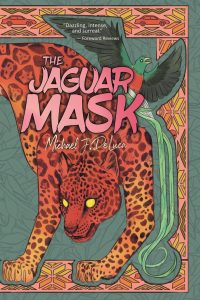The Jaguar Mask by Michael J. DeLuca: Review by Niall Harrison
 The Jaguar Mask, Michael J. DeLuca (Stelliform 978-1-77809-260-2, 348pp, $19.00, tp) August 2024. Cover by Julia Louise Pereira.
The Jaguar Mask, Michael J. DeLuca (Stelliform 978-1-77809-260-2, 348pp, $19.00, tp) August 2024. Cover by Julia Louise Pereira.
The story of The Jaguar Mask does not start on the first page, in which the artist Cristina Ramos relives the murder of her mother in a garish vision – four tattooed mareros with machine pistols, haloed by angels of death, gunning down two government employees, a foreign lobbyist, and Eufemia Ramos, the proprietor of the Guatemala City restaurant in which they are eating – nor does it start when the cab driver Felipe K’icab picks up a client who can’t be refused – the bullying former inspector Rodrigo Zamora, known as El Bufo for his toadlike appearance, on his way to investigate the crime scene. No, the story begins off-screen and in a much wealthier room, with the decision to commit a slower kind of violence, an example of which is also witnessed by Cristina, later in the novel, out in rural Guatemala:
Toiling up and downhill past steep milpas and concrete block farmsteads, she reached the highway. On the steep hillside above, big machines rumbled spreading a foul miasma. Police slept in their pickups. An opaque, stinking yellow liquid spilled down a distant slope and through a rusted corrugated pipe, eroding an ugly gully undermining the road. Nobody was fixing it.
It is too easy to describe this writing, with its perfectly timed back-and-forth between images of pungent decay and peacefully indifferent authority, as dystopian, because it is, of course, only realism. The scene depicts the immediate local consequence of unregulated, unconstrained mining; Cristina’s vision depicts a later and downstream consequence, but it is part of the same process. The Jaguar Mask is a case study of people caught in the machinery of what the Chilean writer Martín Arboleda calls the planetary mine, the extraction of mineral wealth from a poorer territory and its injection into transnational commerce by corporations from the richer world, for the benefit of the richer world: the sort of thing that is poisoning environments and peoples up and down Central and South America, and beyond.
More precisely, The Jaguar Mask is a novel about what the people caught in that machinery do when they can’t ignore it any longer. Cristina begins the novel frustrated but, she believes, realistic. She laments the “shallow romanticism” of the tourists who buy her art, and in providing her primary market, restrict what kind of artist she can be, forcing her to suppress the visions that appear to reveal other truths about the world; and she recognises the injustice of the world but is sceptical of protest and activism as “recklessness,” because “it put people at risk besides yourself.” Felipe, meanwhile, is something of a drifter. He lives with a pair of activists, but does not join them in their work, for an exaggerated version of the same reason as Cristina. Felipe is a shapeshifter, a jaguar in his undirected form (although he declares he is not “truly” a jaguar or a man), but capable of assuming a range of human appearances when wearing masks such as the one mentioned in the novel’s title. He is in Guatemala City to hide, as a way of protecting his family from the suspicion that followed him after the mask once slipped, and perhaps in hope that he might learn more about himself. He appears to be an aberration, an isolated case; he reflects that he has “not even one thread of connection…. back past war and conquest” to whatever lineage he represents. Neither Cristina’s position, nor Felipe’s, can hold in the face of the investigation into which they are both drawn.
DeLuca’s writing throughout is densely sensorial, and coldly furious in a manner reminiscent of the heightened realism of Yuri Herrera, and it is shown off best in a series of astonishing set-piece events involving Cristina. When Cristina and Felipe are caught up in a protest against police murder of campesinos in one mining region, DeLuca gives himself full reign: the placards, the faces, the noise, the incongruity when tear gas grenades are launched “leisurely, like birds, trailing expanding plumes”; Cristina’s gift allows her to see the protest “from a thousand vantages at once,” to visualise the crowd as “a huge, living entity,” but also notice details like employees in upmarket stores hiding behind “posh mannequins.” Contrastingly, at Eufemia’s funeral, the moment when Cristina’s self-protective stance begins to crumble, the drama is almost entirely internal, and we are almost lost in Cristina’s palpable exhaustion, her sense of disconnectedness from the world around her. These are scenes to live in.
But nevertheless there is, I think, a problem with The Jaguar Mask, one that it is aware of but does not solve. This a novel that uses the fantastic to limn the emotional journey to radicalism and it has to somehow end with honesty. The shape of the ending can be discerned from early on in Felipe’s sections. The investigative arc, the pattern of Felipe’s relationship with El Bufo, the arrest of one of his roommates during the protest, and their subsequent disappearance by the militarised security services of the Guatemalan state: Here is a problem that can be solved, a victory that can be achieved by a character who embodies the environment, who can symbolically stand against the larger crime as well as the immediate one. It can be called an ending without being the ending. There is even explicit acknowledgement that just as Eufemia’s murder did not begin the story, this victory cannot end it, that lasting change comes from a grind. And yet, the victory seems to be less limited than the actual circumstances deserve; not the ending, but more than just an ending; a down payment that the ending is on its way. It is almost certainly meant to be inspirational. We need inspiration, and I respect the effort, and it might be the hardest problem to solve in environmental fiction; but in this case, given the intensity of what came before, the final pages felt to me more like a consolation, or at least the most extravagant moment of fantasy in an otherwise laudable novel.
Interested in this title? Your purchase through the links below brings us a small amount of affiliate income and helps us keep doing all the reviews you love to read!
In Niall Harrison‘s spare time, he writes reviews and essays about sf. He is a former editor of Vector (2006-2010) and Strange Horizons (2010-2017), as well as a former Arthur C. Clarke Award judge and various other things.
This review and more like it in the September 2024 issue of Locus.
While you are here, please take a moment to support Locus with a one-time or recurring donation. We rely on reader donations to keep the magazine and site going, and would like to keep the site paywall free, but WE NEED YOUR FINANCIAL SUPPORT to continue quality coverage of the science fiction and fantasy field.
©Locus Magazine. Copyrighted material may not be republished without permission of LSFF.








